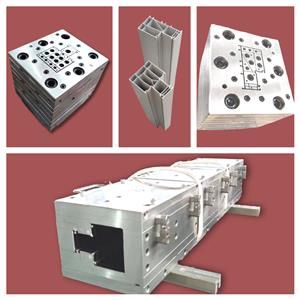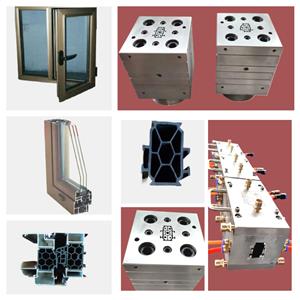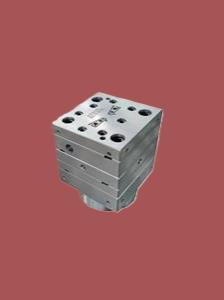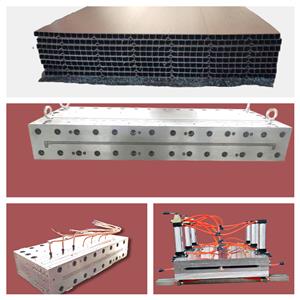Plastik PVC, pembinaan acuan penyemperitan, mendedahkan tudung untuk anda
Terdapat dua bentuk acuan yang biasa digunakan: acuan berpijak plat dan acuan kecerunan keratan rentas. Laluan aliran acuan berpijak plat berubah dalam langkah, yang diperbuat daripada beberapa templat mulut yang disambungkan secara bersiri. Setiap plat dimesin menjadi bentuk kontur yang sepadan, yang secara beransur-ansur berubah daripada bentuk bulat salur masuk ke bentuk alur keluar yang diingini. Terdapat serong di bahagian masuk setiap blok untuk melengkapkan peralihan dari satu bentuk ke bentuk yang lain. Kos pemprosesan acuan jenis ini adalah rendah, saluran aliran tidak sesuai diperkemas, dan secara amnya tidak perlu digunakan sebagai profil utama. Pelari acuan kecerunan bahagian diperkemas, tidak boleh ada zon pengekalan bahan dalam pelari, leburan diagihkan secara beransur-ansur dan tepat ke setiap bahagian bentuk alur keluar dari bulatan di salur masuk, dan kelajuan meningkat secara berterusan kepada kelajuan alur keluar yang diperlukan, dan kelajuan setiap titik pada bahagian adalah sama. Untuk profil plastik PVC dengan teras acuan yang kompleks, teras acuan sama ada disepadukan dengan plat pendakap, ada yang dipasang pada plat pendakap dengan mencari pin dan skru, dan ada yang dibenamkan pada plat pendakap dengan tatahan ketat. Ia tidak boleh dibuka dengan mudah semasa digunakan, kerana ia memakan masa untuk memasang semula dan nyahpepijat. Pisau leburan juga dilakukan dalam dua cara: pada kon shunt, dan dalam bahagian mampatan. Acuan kecerunan bahagian boleh digunakan sebagai acuan profil utama. Acuan penyemperitan profil plastik PVC adalah bahagian teras barisan pengeluaran penyemperitan, yang termasuk die mulut (juga dikenali sebagai kepala die), acuan membentuk, tangki air penyejuk, dll. Die mulut dipasang dengan bebibir pada kepala penyemperit dengan cara bebibir, dan gelang pemanas, plat pemanas, bekalan kuasa dan termokopel disambungkan. Acuan membentuk dan tangki air penyejuk dipasang pada meja membentuk dengan skru, dan paip air dan paip gas disambungkan. Struktur asas acuan penyemperitan secara amnya direka bentuk sebagai struktur pelbagai templat yang disusun dan dipasang. Oleh itu, saluran aliran keseluruhan die dibentuk dengan menyambungkan salah satu saluran aliran dalam setiap bahagian templat, depan dan belakang. Kerja plat diletakkan dan diikat dengan pin dan bolt untuk membentuk acuan penyemperitan monolitik. Situasi asasnya ialah: bahagian aliran mantap die penyemperitan selalunya terdiri daripada plat berlubang dan separuh bahagian depan leher, dan bahagian depan dan separuh kedua leher juga direka bentuk sebagai dua templat, leher dan leher. plat peralihan leher. Ia juga mungkin untuk tidak menggunakan plat berliang, tetapi untuk mereka bentuk separuh hadapan saluran aliran leher ke saluran aliran silinder untuk menstabilkan aliran. Bahagian pecahan die penyemperitan bermula dari separuh kedua leher dan termasuk kon terbelah, plat pendakap terbelah dan plat pengecut. Plat pengecutan boleh dibahagikan bukan kepada satu acuan, tetapi bersama-sama dengan plat yang telah dibentuk - acuan. Bahagian membentuk acuan penyemperitan melibatkan templat berikut: plat rongga (juga dikenali sebagai plat prabentuk), templat mulut (juga dikenali sebagai plat pembentuk) dan teras (juga dikenali sebagai teras acuan). Untuk cetakan profil yang lebih ringkas, plat yang telah dibentuk digabungkan dengan templat mulut menjadi satu acuan. 1. Perkara utama reka bentuk keratan rentas produk Perkara utama reka bentuk produk profil plastik PVC ialah ketebalan dan bentuk setiap bahagian hendaklah diagihkan secara simetri, supaya aliran bahan dalam kepala mesin seimbang, penyejukan boleh menjadi seragam , dan tekanan cenderung seimbang. Secara umumnya, ketebalan dinding maksimum dan ketebalan dinding minimum bahagian yang sama adalah berbeza < 50% is appropriate. If it is a part of a closed rib, the thickness of the rib should be 20% thinner than the wall thickness. In order to avoid the stress concentration at the corner of PVC plastic profile products, the shape change of the product should be smooth and smooth transition, generally the outer corner R is not less than 0.5mm, the inner corner R is not less than 0.25mm. The hollow part of the product should not be too small. The cross-sectional shape is preferably symmetrical. 2. Structure type and design principle of mold The mold is the forming part of the extruder, which is mainly composed of neck seat, shunt cone, support plate (also known as bracket), core mold, mouth template and adjusting screw. PVC plastic profile extrusion die county is mainly composed of three sections: feeding section one by machine base and distribution cone composed of machine head flow channel feeding section, is conical: melt distribution and forming section one by support plate and mouth die compression part constitute melt distribution and forming section, the shape is gradually close to the PVC plastic profile section, parallel section mouth die and core die constitute the machine head parallel section, (1) There are two types of mold structure for extruded plastic profiles: plate head and streamlined head. According to the different methods of processing and manufacturing the machine head, the streamlined head fork is divided into integral streamlined and segmented (also known as stepped) streamlined. (2) Mold design principle The mold is the key part of PVC plastic profile extrusion, and its function is to extrude a blank similar to the profile under the action of 10~25MPa extrusion force. PVC plastic profile mold runner design principle is that the runner section should be streamlined: there is enough compression ratio and shaped length to form a certain extrusion pressure: the flow resistance balance and flow symmetry of the cross-sectional gap of each runner part of the mold. The flow channel structure of the PVC plastic profile head is generally divided into three parts: feeding, compression (also known as transition part) and forming. Generally speaking, the length of the feed part of the long runner is 1 of the length of the shaping part. About 5~2 times, the length of the compression part is about 2~3 times the length of the shaping part. The maximum cross-sectional area of the compression section is in the outlet area of the bracket. The shape of the support ribs of the bracketer. The broad one is jujube nucleus-shaped. The thin ones are long prismatic. The shape of the divergence in the front of the scaffold is that it converges at the same angle on all sides, forming a torpedo body shape. The flow rate of molten material is different in the flow channel of feeding, compression and forming, the feeding part is the smallest, the forming part is the largest, and the transition part must be in between the two and gradually increase in the direction of extrusion. The melt flow rate is inversely proportional to the cross-sectional area of the runner. The roughness of the runner in the head should be Ra0. 4~0.8ym, the roughness of the mouth mold runner of the stereotyped part is higher than the roughness of the inner runner, which should be Ra0.2~0. 4μm, When the extruded billet is just exported to the die, the size of the gap is increased than the mouth die, which is called the mold release expansion, that is, the Balas effect. This effect must be considered when the pulling speed of PVC plastic profile extrusion is slow and it is cooled near the outlet of the die mold. The release mold expansion of the outlet die is usually calculated by volume, and its expansion rate is generally 1.5~2.5 times, and this value changes with different aspects of melt temperature, pressure and velocity. The wall thickness size required for PVC plastic profiles depends on the wall thickness of the appropriate extruded billet on the one hand, and the pulling speed and extrusion amount on the other hand. The thickness of the extrusion blank wall mainly depends on the size of the mouth die gap, and then depends on the plasticizing performance of the material in the extruder, extrusion pressure, extrusion temperature, material performance and expansion value. First, the standard traction shrinkage rate for general wall thickness is ≤2.5%. The gap between the mouth die and the thickness of the product are taken (0.8~0.9) 1 1




